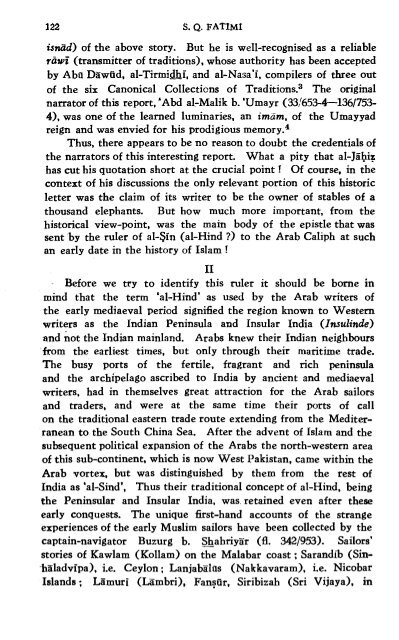TWO LETTERS FROM THE MAHARAJA TO THE KHALIFAH
TWO LETTERS FROM THE MAHARAJA TO THE KHALIFAH
TWO LETTERS FROM THE MAHARAJA TO THE KHALIFAH
You also want an ePaper? Increase the reach of your titles
YUMPU automatically turns print PDFs into web optimized ePapers that Google loves.
isniid) of the above story. But he is well-recognised as a reliable<br />
rawT (transmitter of traditions), whose authority has been accepted<br />
by Abil Dswiid, al-Tirmihi, and al-Nasa'i, compilers of three out<br />
of the six Canonical Collecticns of tradition^.^ The original<br />
narrator of this report, 'Abd al-Malik b. 'Umayr (33!653-4-1361753-<br />
4). was one of the learned luminaries, an imam, of the Umayyad<br />
reign and was envied for his prodigious mem~ry.~<br />
Thus, there appears to be no reason to doubt the credentials of<br />
the narrators of this interesting report. What a pity that al-J%hi?;<br />
has cut his quotation short at the crucial point ! Of course, in the<br />
context of his discussions the only relevant portion of this historic<br />
letter was the claim of its writer to be the owner of stables of a<br />
thousand elephants. But how much more important, from the<br />
historical view-point, was the main body of the epistle that was<br />
sent by the ruler of al-Sin (al-Hind ?) to the Arab Caliph at such<br />
an early date in the history of Islam !<br />
I1<br />
Before we try to identify this ruler it should be borne in<br />
mind that the term 'al-Hind' as used by the Arab writers of<br />
the early mediaeval period signified the region known to Western<br />
writers as the Indian Peninsula and Insular India (Insulinde)<br />
and not the Indian mainland. Arabs knew their Indian neighbours<br />
from the earliest times, but only through their maritime trade.<br />
The busy ports of the fertile, fragrant and rich peninsula<br />
and the archipelago ascribed to India by ancient and mediaeval<br />
writers. had in themselves great attraction for the Arab sailors<br />
and traders, and were at the same time their ports of call<br />
on the traditional eastern trade route extending from the Mediter-<br />
ranean to the South China Sea. After the advent of Islam and the<br />
subsequent political expansion of the Arabs the north-western area<br />
of this sub-continent, which is now West Pakistan, came within the<br />
Arab vortex. but was distinguished by them from the rest of<br />
India as 'al-Sind', Thus their traditional concept of al-Hind. being<br />
the Peninsular and Insular India, was retained even after these<br />
early conquests. The unique first-hand accounts of the strange<br />
experiences of the early Muslim sailors have been collected by the<br />
captain-navigator Buzurg b. &ahrip& (fl. 3421953). Sailors'<br />
stories of Kawlam (Kollam) on the Malabar coast ; Sarandib (Sin-<br />
hdadvipa). i.e. Ceylon ; Lanjab~lils (Nakkavaram). i.e. Nicobar<br />
Islands; Lamuri (Umbri), Fanstir, Siribizah (Sri Vijaya), in
















